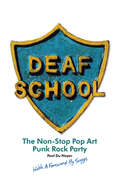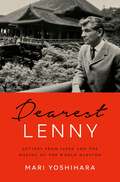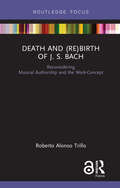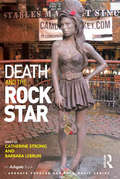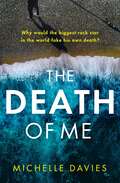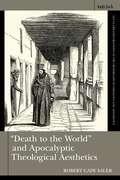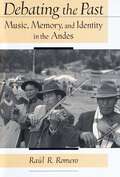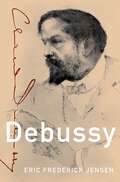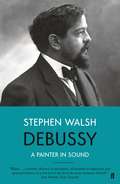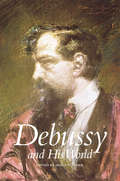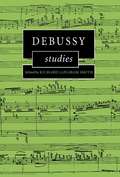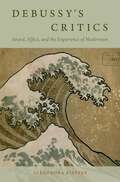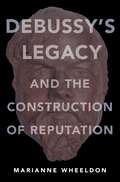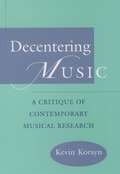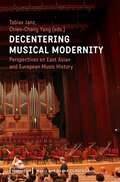- Table View
- List View
Deaf School: The Non-Stop Pop Art Punk Rock Party
by Paul Du NoyerLiverpool’s dynamic music scene gave the world The Beatles. What city could hope to follow that? But 12 years later, in 1974, lightning nearly struck twice. Deaf School were a band formed in John Lennon’s old art college, rehearsing in the very same rooms. With their chaotic and wildly entertaining brand of rock cabaret, Deaf School were tipped for instant stardom and signed up by Warner Brothers in California. But suddenly, with the world at their feet, Deaf School were swept aside by Britain’s punk rock revolution. “A great band,” said the Sex Pistols’ manager Malcolm McLaren. “But it’s just as bad being too early as too late.” Though their hopes were dashed the band has never surrendered. And 40 years on, Deaf School’s influence is acknowledged by British bands from Madness to Dexy's Midnight Runners. Their reunion shows, still madly glamorous and eccentric, are tribal gatherings for a fanbase that never forgot them. The band’s first full-length biography is written by British music writer Paul Du Noyer, a follower since Deaf School’s early days in Liverpool. “Deaf School are such a delicious secret,” he says. “It’s almost a shame to reveal it.”
Dearest Lenny: Letters from Japan and the Making of the World Maestro
by Mari YoshiharaMuch has been written about Leonard Bernstein, a musician of extraordinary talent who was legendary for his passionate love of life and many relationships. In this work, Mari Yoshihara reveals the deeply emotional connections Bernstein formed with two little-known Japanese individuals, which she narrates through their personal letters that have never been seen before. Dearest Lenny interweaves an intimate story of love and art with a history of Bernstein's transformation from an American icon to a world maestro during the second half of the twentieth century. The articulate, moving letters of Kazuko Amano--a woman who began writing fan letters to Bernstein in 1947 and became a close family friend--and Kunihiko Hashimoto--a young man who fell in love with the maestro in 1979 and later became his business representative--convey the meaning Bernstein and his music had at various stages of their lives. The letters also shed light on how Bernstein's compositions, recordings, and performances touched his audiences around the world. The book further traces the making of a global Bernstein amidst the shifting landscape of classical music that made this American celebrity turn increasingly to Europe and Japan. The dramatic change in Japan's place in the world and its relationship to the United States during the postwar decades shaped Bernstein's connection to the country. Ultimately, Dearest Lenny is a story of relationships--between the two individuals and Bernstein, the United States and the world, art and commerce, artists and the state, private and public, conventions and transgressions, dreams and realities--that were at the core of Bernstein's greatest achievements and challenges and that made him truly a maestro of the world. Dearest Lenny paints a poignant portrait of individuals connected across cultures, languages, age, and status through correspondence and music--and the world that shaped their relationships.
Dearest Lenny: Letters from Japan and the Making of the World Maestro
by Mari YoshiharaMuch has been written about Leonard Bernstein, a musician of extraordinary talent who was legendary for his passionate love of life and many relationships. In this work, Mari Yoshihara reveals the deeply emotional connections Bernstein formed with two little-known Japanese individuals, which she narrates through their personal letters that have never been seen before. Dearest Lenny interweaves an intimate story of love and art with a history of Bernstein's transformation from an American icon to a world maestro during the second half of the twentieth century. The articulate, moving letters of Kazuko Amano--a woman who began writing fan letters to Bernstein in 1947 and became a close family friend--and Kunihiko Hashimoto--a young man who fell in love with the maestro in 1979 and later became his business representative--convey the meaning Bernstein and his music had at various stages of their lives. The letters also shed light on how Bernstein's compositions, recordings, and performances touched his audiences around the world. The book further traces the making of a global Bernstein amidst the shifting landscape of classical music that made this American celebrity turn increasingly to Europe and Japan. The dramatic change in Japan's place in the world and its relationship to the United States during the postwar decades shaped Bernstein's connection to the country. Ultimately, Dearest Lenny is a story of relationships--between the two individuals and Bernstein, the United States and the world, art and commerce, artists and the state, private and public, conventions and transgressions, dreams and realities--that were at the core of Bernstein's greatest achievements and challenges and that made him truly a maestro of the world. Dearest Lenny paints a poignant portrait of individuals connected across cultures, languages, age, and status through correspondence and music--and the world that shaped their relationships.
Death and (Re) Birth of J.S. Bach: Reconsidering Musical Authorship and the Work-Concept
by Roberto Alonso TrilloWhile the study and redefinition of the notion of authorship and its relationship to the idea of the literary work have played a central role in recent research on literature, semiotics, and related disciplines, its impact on contemporary musicology is still limited. Why? What implications would a reconsideration of the author- and work-concepts have on our understanding of the creative musical processes? Why would such a re-examination of these regulative concepts be necessary? Could it emerge from a post-structuralist revision of the notion of musical textuality? In this book, Trillo takes the …Bach… project, a collection of new music based on Johann Sebastian Bach’s Partita No.1 for solo violin, BWV 1002, as a point of departure to sketch some critical answers to these fundamental questions, raise new ones, and explore their musicological implications.
Death and (Re) Birth of J.S. Bach: Reconsidering Musical Authorship and the Work-Concept
by Roberto Alonso TrilloWhile the study and redefinition of the notion of authorship and its relationship to the idea of the literary work have played a central role in recent research on literature, semiotics, and related disciplines, its impact on contemporary musicology is still limited. Why? What implications would a reconsideration of the author- and work-concepts have on our understanding of the creative musical processes? Why would such a re-examination of these regulative concepts be necessary? Could it emerge from a post-structuralist revision of the notion of musical textuality? In this book, Trillo takes the …Bach… project, a collection of new music based on Johann Sebastian Bach’s Partita No.1 for solo violin, BWV 1002, as a point of departure to sketch some critical answers to these fundamental questions, raise new ones, and explore their musicological implications.
Death and the Rock Star (Ashgate Popular and Folk Music Series)
by Catherine Strong Barbara LebrunThe untimely deaths of Amy Winehouse (2011) and Whitney Houston (2012), and the ’resurrection’ of Tupac Shakur for a performance at the Coachella music festival in April 2012, have focused the media spotlight on the relationship between popular music, fame and death. If the phrase ’sex, drugs and rock’n’roll’ ever qualified a lifestyle, it has left many casualties in its wake, and with the ranks of dead musicians growing over time, so the types of death involved and the reactions to them have diversified. Conversely, as many artists who fronted the rock’n’roll revolution of the 1950s and 1960s continue to age, the idea of dying young and leaving a beautiful corpse (which gave rise, for instance, to the myth of the ’27 Club’) no longer carries the same resonance that it once might have done. This edited collection explores the reception of dead rock stars, ’rock’ being taken in the widest sense as the artists discussed belong to the genres of rock’n’roll (Elvis Presley), disco (Donna Summer), pop and pop-rock (Michael Jackson, Whitney Houston, Amy Winehouse), punk and post-punk (GG Allin, Ian Curtis), rap (Tupac Shakur), folk (the Dutchman André Hazes) and ’world’ music (Fela Kuti). When music artists die, their fellow musicians, producers, fans and the media react differently, and this book brings together their intertwining modalities of reception. The commercial impact of death on record sales, copyrights, and print media is considered, and the different justifications by living artists for being involved with the dead, through covers, sampling and tributes. The cultural representation of dead singers is investigated through obituaries, biographies and biopics, observing that posthumous fame provides coping mechanisms for fans, and consumers of popular culture more generally, to deal with the knowledge of their own mortality. Examining the contrasting ways in which male and female dead singers are portrayed in the media, the book
Death and the Rock Star (Ashgate Popular and Folk Music Series)
by Catherine Strong Barbara LebrunThe untimely deaths of Amy Winehouse (2011) and Whitney Houston (2012), and the ’resurrection’ of Tupac Shakur for a performance at the Coachella music festival in April 2012, have focused the media spotlight on the relationship between popular music, fame and death. If the phrase ’sex, drugs and rock’n’roll’ ever qualified a lifestyle, it has left many casualties in its wake, and with the ranks of dead musicians growing over time, so the types of death involved and the reactions to them have diversified. Conversely, as many artists who fronted the rock’n’roll revolution of the 1950s and 1960s continue to age, the idea of dying young and leaving a beautiful corpse (which gave rise, for instance, to the myth of the ’27 Club’) no longer carries the same resonance that it once might have done. This edited collection explores the reception of dead rock stars, ’rock’ being taken in the widest sense as the artists discussed belong to the genres of rock’n’roll (Elvis Presley), disco (Donna Summer), pop and pop-rock (Michael Jackson, Whitney Houston, Amy Winehouse), punk and post-punk (GG Allin, Ian Curtis), rap (Tupac Shakur), folk (the Dutchman André Hazes) and ’world’ music (Fela Kuti). When music artists die, their fellow musicians, producers, fans and the media react differently, and this book brings together their intertwining modalities of reception. The commercial impact of death on record sales, copyrights, and print media is considered, and the different justifications by living artists for being involved with the dead, through covers, sampling and tributes. The cultural representation of dead singers is investigated through obituaries, biographies and biopics, observing that posthumous fame provides coping mechanisms for fans, and consumers of popular culture more generally, to deal with the knowledge of their own mortality. Examining the contrasting ways in which male and female dead singers are portrayed in the media, the book
Death Metal (Genre: A 33 1/3 Series)
by T ColesSteeped in foreboding mythology, the dark underbelly of heavy metal ignites debate to this day. Guitars playing abrasive, discordant riffs, the thunderous double-kick of the drums acting like an accelerated heartbeat, and porcine, guttural vocals pummeling twisted lyrics. Courting controversy from inception to its modern day iteration, death metal presents a number of contradictions: Driven and adventurous musicians compete to make uncomfortable noises; it is crude and far beyond parody and yet consistently popular; and the music is pig-headedly uncommercial despite making a few labels, albeit briefly, wealthy. This book explores the history and methodology of the genre, charting its aims and intentions, its crossovers to the mainstream, successes and failures, and tracks how it developed from the bedrooms of Birmingham and Florida to the near-mainstream, to the murky cult status it enjoys today.
Death Metal (Genre: A 33 1/3 Series)
by T ColesSteeped in foreboding mythology, the dark underbelly of heavy metal ignites debate to this day. Guitars playing abrasive, discordant riffs, the thunderous double-kick of the drums acting like an accelerated heartbeat, and porcine, guttural vocals pummeling twisted lyrics. Courting controversy from inception to its modern day iteration, death metal presents a number of contradictions: Driven and adventurous musicians compete to make uncomfortable noises; it is crude and far beyond parody and yet consistently popular; and the music is pig-headedly uncommercial despite making a few labels, albeit briefly, wealthy. This book explores the history and methodology of the genre, charting its aims and intentions, its crossovers to the mainstream, successes and failures, and tracks how it developed from the bedrooms of Birmingham and Florida to the near-mainstream, to the murky cult status it enjoys today.
The Death of Me
by Michelle Davies'A twisting tale about the dark undercurrents of fame and fortune. You'll read THE DEATH OF ME with your heart in your mouth.' Erin Kelly Is one of music's greatest mysteries about to be solved?'He was a massive star until he did a headline grabbing retreat from the spotlight - but his disappearing act was FAKED. Fans won't be happy when they find out - his reputation was dead in the water.'When Isaac Naylor committed suicide after a teenage fan was found dead in his hotel room, the world thought it had lost one of the greatest rock stars of a generation. Naylor, lead singer of The Ospreys, had been arrested for causing the girl's death and was on police bail when he drowned himself in the sea off the Devon coast.Now, eight years on, music journalist Natalie Glass stumbles across a blind item on a US gossip website that suggests Naylor's death wasn't quite what it seemed - and he might in fact still be alive.But as she delves deeper into what happened, Natalie finds she has a stark choice: give up trying to find out what happened to Naylor or risk her own obituary ending up in print.
"Death to the World" and Apocalyptic Theological Aesthetics (T&T Clark Explorations at the Crossroads of Theology and Aesthetics)
by Robert Cady SalerRobert Saler examines the small but influential Death to the World movement in US Eastern Orthodox Christianity. Presenting a case study in theological aesthetics, Saler demonstrates how a relatively small consumer phenomenon within US Eastern Orthodoxy sits at the centre of a variety of larger questions, including:- The relationship between formal ecclesial and para-church structures - The role of the Internet in modern religiosity - Consumer structures and patterns as constitutive of piety- How theology can help us understand art and vice versaUnderstanding "Death to the World" as an instance of lived religion tied to questions of identity, politics of religious purity, relationships to capitalism, and concerns over conspiracy theory helps us to see how studies of uniquely American Eastern Orthodox identity must address these broader cultural strands.
"Death to the World" and Apocalyptic Theological Aesthetics (T&T Clark Explorations at the Crossroads of Theology and Aesthetics)
by Robert Cady SalerRobert Saler examines the small but influential Death to the World movement in US Eastern Orthodox Christianity. Presenting a case study in theological aesthetics, Saler demonstrates how a relatively small consumer phenomenon within US Eastern Orthodoxy sits at the centre of a variety of larger questions, including:- The relationship between formal ecclesial and para-church structures - The role of the Internet in modern religiosity - Consumer structures and patterns as constitutive of piety- How theology can help us understand art and vice versaUnderstanding "Death to the World" as an instance of lived religion tied to questions of identity, politics of religious purity, relationships to capitalism, and concerns over conspiracy theory helps us to see how studies of uniquely American Eastern Orthodox identity must address these broader cultural strands.
Debating The Past: Music, Memory, And Identity In The Andes
by Raúl R. RomeroThis volume examines how the search for "cultural authenticity," the dispute over the past, and the role of "modernity" have been instrumental in building the regional musical culture of the Mantaro Valley, a central Peruvian region with about half a million inhabitants. How these people have addressed concerns over the loss of ancient traditions by restructuring colonial and pre-Hispanic traditions into new contexts and forms is explored. Covering private and public music making, along with ritual, ceremonial, and popular uses of music, Romero studies the interaction of music and identity. The book is concerned with a modern regional culture, situated and defined in the context of an emergent nation, which is struggling to build a distinct cultural identity and to recreate values.
Debating the Past: Music, Memory, and Identity in the Andes
by Raul R. RomeroThis volume examines how the search for "cultural authenticity," the dispute over the past, and the role of "modernity" have been instrumental in building the regional musical culture of the Mantaro Valley, a central Peruvian region with about half a million inhabitants. How these people have addressed concerns over the loss of ancient traditions by restructuring colonial and pre-Hispanic traditions into new contexts and forms is explored. Covering private and public music making, along with ritual, ceremonial, and popular uses of music, Romero studies the interaction of music and identity. The book is concerned with a modern regional culture, situated and defined in the context of an emergent nation, which is struggling to build a distinct cultural identity and to recreate values.
Debussy (Master Musicians Series)
by Eric Frederick JensenNearly one hundred years after the death of its composer, the music of Claude Debussy has lost none of its breadth of appeal. With the rare ability to entice listeners on many levels, at its heart lies an engaging simplicity-one which defies traditional analysis and lends mystery to what ultimately is an extremely refined and highly personal approach to composition. Equally fascinating is Debussy's often contradictory personality--at times elusive, but always centered on his devotion to music and his ambition to create a name for himself unlike any other. Author Eric Frederick Jensen provides new insight to the man and the music in this authoritative biography. Although born into poverty, and a failure as a piano student at the Paris Conservatoire, Debussy became the most famous French composer of his day, known for his culture and refinement. His revolutionary music baffled critics but was embraced by audiences. Debussy's scandalous personal life stirred up as much controversy as his music, and his notoriety proved more harmful to his career than the unusual nature of his compositions. Jensen also explores Debussy's relationship to the arts and his career as a music critic. Debussy drew on all of the arts in his development as a composer, including poetry and painting, and his fascination with the arts has often led to his being classified as an Impressionist or Symbolist, two claims which Jensen debunks. One of the finest music critics of his time, Debussy's reviews reveal a great deal not only about his musical taste, but also about what he felt the role and function of music should be. Debussy brings together the most recent biographical research, including a revised catalogue of Debussy's compositions and the first complete edition of his correspondence. With separate, chronological sections on his life and music, Debussy is accessible to the general reader who wishes to focus on his life and personality, while providing detailed discussion of the music to musicians and students.
Debussy (Master Musicians Series)
by Eric Frederick JensenNearly one hundred years after the death of its composer, the music of Claude Debussy has lost none of its breadth of appeal. With the rare ability to entice listeners on many levels, at its heart lies an engaging simplicity-one which defies traditional analysis and lends mystery to what ultimately is an extremely refined and highly personal approach to composition. Equally fascinating is Debussy's often contradictory personality--at times elusive, but always centered on his devotion to music and his ambition to create a name for himself unlike any other. Author Eric Frederick Jensen provides new insight to the man and the music in this authoritative biography. Although born into poverty, and a failure as a piano student at the Paris Conservatoire, Debussy became the most famous French composer of his day, known for his culture and refinement. His revolutionary music baffled critics but was embraced by audiences. Debussy's scandalous personal life stirred up as much controversy as his music, and his notoriety proved more harmful to his career than the unusual nature of his compositions. Jensen also explores Debussy's relationship to the arts and his career as a music critic. Debussy drew on all of the arts in his development as a composer, including poetry and painting, and his fascination with the arts has often led to his being classified as an Impressionist or Symbolist, two claims which Jensen debunks. One of the finest music critics of his time, Debussy's reviews reveal a great deal not only about his musical taste, but also about what he felt the role and function of music should be. Debussy brings together the most recent biographical research, including a revised catalogue of Debussy's compositions and the first complete edition of his correspondence. With separate, chronological sections on his life and music, Debussy is accessible to the general reader who wishes to focus on his life and personality, while providing detailed discussion of the music to musicians and students.
Debussy: A Painter in Sound
by Professor Stephen WalshDebussy's life is of extraordinary interest because, like Wagner and Stravinsky, he crossed artistic boundaries, associating as much with poets and artists as with musicians. His father was active in the 1871 Paris Commune and the composer's childhood was thus unsettled, his musical preparation erratic, and his subsequent lifestyle somewhat bohemian by the bourgeois norms of the French musical establishment. He never went to a proper school, but was enough of a pianist to enter the Paris Conservatoire at the age of 10. Whilst still a student he rebelled against the academy-taught "rules of composition" and constructed a language of his own, in constant rebellion against the heavy Wagnerian influence prevalent at that time.In the early 1900s he worked in Paris as a music critic. His own music during these years includes some of the greatest and most influential works of the early twentieth century: the opera Pelléas et Mélisande, his orchestral masterpieces La Mer and Images, a series of profoundly original piano works (including two books of Préludes), and the ballet Jeux, premiered in Diaghilev's 1913 season just before Stravinsky's Rite of Spring (which Debussy attended). His later years were plagued by the rectal cancer that eventually killed him in 1918. But he continued to compose until 1917This was a period of political and cultural turmoil in French life, the Franco-Prussian war and its aftermath, the Dreyfus affair with its religious and military undercurrents, the general instability of the Third Republic, and the First World War. Stephen Walsh's study combines chronological biography with a contextualised picture placing Debussy in the broad artistic and social environment of turn-of-the-century France, making this a significant contribution to the cultural history of the time.
Debussy and His World (PDF)
by Jane FulcherClaude Debussy's Paris was factionalized, politicized, and litigious. It was against this background of ferment and change--which characterized French society and music from the Franco-Prussian War to World War I--that Debussy re-thought music. This book captures the complexity of the composer's restless personal and artistic identity within the new picture emerging of the musical, social, and political world of fin-de-siècle Paris. Debussy's setting did not simply mold his style. Rather, it challenged him to define a style and then to revamp it again and again as he situated himself simultaneously via the present and the past. These essays trace Debussy's perpetual reinvention, both social and creative, from his earliest to his last works. They explore tensions and contradictions in his best-known compositions and examine lesser-known pieces that reveal new aspects of Debussy's creative appropriation from poetry, painting, and non-Western music. The contributors reveal the extent to which Debussy's personal and professional lives were intertwined and sometimes in conflict. Belonging to no one group or class, but crossing many, Debussy abjured the orthodox. A maverick who reviled all convention and searched for a music that authentically reflected experience, Debussy balked at entering any situation--salons, musical societies, or factions--that would categorize and thus distort him. Because of this, music lovers still argue over the degree to which Debussy's music is Impressionist, symbolist, or even French. Aptly, the volume's editor reads Debussy's last works as a dialogue with himself that reflects his inherently pluralistic, paradoxical, negotiated, and ever-changing identity. William Austin's description of Debussy as ''one of the most original and adventurous musicians who ever lived'' is often repeated. This book illustrates how right Austin was and shows why Debussy's unclassifiable art continues to fascinate and perplex his historians even as it enthralls new listeners. The contributors are Leon Botstein, Christophe Charle, John Clevenger, Jane F. Fulcher, David Grayson, Brian Hart, Gail Hilson-Woldu, and Marie Rolf.
Debussy Studies (Cambridge Composer Studies)
by Richard Langham SmithOur knowledge of Debussy's life and music has increased considerably during the last decade or so, largely through the efforts of those working on the long overdue complete edition of his music. Many of the contributors to this volume, first published in 1997, have worked on various pieces in the complete edition and the significance of their research is apparent here. Topics include an examination of Debussy's working methods, his visual tastes and his response to literature, his reception in England, as well as aspects of performance practice. It also includes a close study of Debussy's relationship to the poet Stéphane Mallarmé. An appendix reproduces a discarded scene from Maeterlinck's 'Pelléas' for the first time, and the book is particularly rich in previously unpublished facsimiles and other little-known illustrative material.
Debussy's Critics: Sound, Affect, and the Experience of Modernism
by Alexandra KiefferDebussy's Critics: Sound, Affect, and the Experience of Modernism explores the music of Claude Debussy and its early reception in light of the rise of the empirical human sciences in Western Europe around the turn of the twentieth century. In the midst of a sea change in conceptions of the human person, the critics who wrote about Debussy's music in the Parisian press-continually returning to this music's nebulous relationship to sensation and sensibilité-attempted to articulate a music aesthetic appropriate to the fully embodied, material self of psychological modernism. While scholarship on French music in this period has often emphasized its affinities with other art forms, such as Impressionist painting and Symbolist poetry, Debussy's Critics demonstrates that a preoccupation with the specifically sonic materiality of Debussy's music, informed by late nineteenth-century scientific discourses on affect, perception, and cognition, was central to this music's historical intervention. Foregrounding the dynamic exchange between sounds and ideas, this book reveals the disorienting and bewildering experience of listening to Debussy's music, which compelled its early audiences to reimagine the most fundamental premises of the European art-music tradition.
Debussy's Critics: Sound, Affect, and the Experience of Modernism
by Alexandra KiefferDebussy's Critics: Sound, Affect, and the Experience of Modernism explores the music of Claude Debussy and its early reception in light of the rise of the empirical human sciences in Western Europe around the turn of the twentieth century. In the midst of a sea change in conceptions of the human person, the critics who wrote about Debussy's music in the Parisian press-continually returning to this music's nebulous relationship to sensation and sensibilité-attempted to articulate a music aesthetic appropriate to the fully embodied, material self of psychological modernism. While scholarship on French music in this period has often emphasized its affinities with other art forms, such as Impressionist painting and Symbolist poetry, Debussy's Critics demonstrates that a preoccupation with the specifically sonic materiality of Debussy's music, informed by late nineteenth-century scientific discourses on affect, perception, and cognition, was central to this music's historical intervention. Foregrounding the dynamic exchange between sounds and ideas, this book reveals the disorienting and bewildering experience of listening to Debussy's music, which compelled its early audiences to reimagine the most fundamental premises of the European art-music tradition.
DEBUSSY'S LEG & CONSTRUCT OF REPUTAT P
by Marianne WheeldonToday, Claude Debussy's position as a central figure in twentieth-century concert music is secure, and scholarship has long taken for granted the enduring musical and aesthetic contributions of his compositions. Yet this was not always the case. Unknown to many concert-goers and music scholars is the fact that for years after his death, Debussy's musical aesthetic was perceived as outmoded, decadent, and even harmful for French music. In Debussy's Legacy and the Construction of Reputation, Marianne Wheeldon examines the vicissitudes of the composer's posthumous reception in the 1920s and 30s, and analyzes the confluence of factors that helped to overturn the initial backlash against his music. Rather than viewing Debussy's artistic greatness as the cause of his enduring legacy, she considers it instead as an effect, tracing the manifold processes that shaped how his music was received and how its aesthetic worth was consolidated. Speaking to readers both within and beyond the domain of French music and culture, Debussy's Legacy and the Construction of Reputation enters into dialogue with research in the sociology of reputation and commemoration, examining the collective nature of the processes of artistic consecration. By analyzing the cultural forces that came to bear on the formation of Debussy's legacy, Wheeldon contributes to a greater understanding of the inter-war period--the cultural politics, debates, and issues that confronted musicians in 1920s and 30s Paris--and offers a musicological perspective on the subject of reputation building, to date underrepresented in recent writings on reputation and commemoration in the humanities. Debussy's Legacy and the Construction of Reputation is an important new study, groundbreaking in its methodology and in its approach to musical influence and cultural consecration.
Debussy's Legacy and the Construction of Reputation
by Marianne WheeldonToday, Claude Debussy's position as a central figure in twentieth-century concert music is secure, and scholarship has long taken for granted the enduring musical and aesthetic contributions of his compositions. Yet this was not always the case. Unknown to many concert-goers and music scholars is the fact that for years after his death, Debussy's musical aesthetic was perceived as outmoded, decadent, and even harmful for French music. In Debussy's Legacy and the Construction of Reputation, Marianne Wheeldon examines the vicissitudes of the composer's posthumous reception in the 1920s and 30s, and analyzes the confluence of factors that helped to overturn the initial backlash against his music. Rather than viewing Debussy's artistic greatness as the cause of his enduring legacy, she considers it instead as an effect, tracing the manifold processes that shaped how his music was received and how its aesthetic worth was consolidated. Speaking to readers both within and beyond the domain of French music and culture, Debussy's Legacy and the Construction of Reputation enters into dialogue with research in the sociology of reputation and commemoration, examining the collective nature of the processes of artistic consecration. By analyzing the cultural forces that came to bear on the formation of Debussy's legacy, Wheeldon contributes to a greater understanding of the inter-war period--the cultural politics, debates, and issues that confronted musicians in 1920s and 30s Paris--and offers a musicological perspective on the subject of reputation building, to date underrepresented in recent writings on reputation and commemoration in the humanities. Debussy's Legacy and the Construction of Reputation is an important new study, groundbreaking in its methodology and in its approach to musical influence and cultural consecration.
Decentering Music: A Critique of Contemporary Musical Research
by Kevin KorsynAs a work of cultural criticism that recalls the concerns of Foucault, Hayden White, Zizek, and others Decentering Music examines the struggle for the authority to speak about music at a time when the humanities are in crisis. By linking the institutions that support musical research, including professional associations and universities, to complex historical changes such as globalization and the commodification of knowledge, Korsyn undertakes a critique of musical scholarship as an institutional discourse, while contributing to a general theory of disciplinary structures that goes beyond the limits of any single field. In asking a number of fundamental questions about the models through which disciplinary objects in music are constructed, Korsyn suggests unexpected relationships between works of musical scholarship and the cultural networks in which they participate. Thus David Lewin's theory of musical perceptions is compared to Richard Rorty's concept of the "liberal ironist," Susan McClary's feminist narrative of music history is juxtaposed with T.S. Eliot's "dissociation of sensibility," and Steven Feld's work in recording the music of the Kaluli people is compared to the treatment of ambient sound in contemporary cinema. Developing a framework for interpretation in dialogue with a number of poststructuralist writers, Korsyn goes far beyond applying their thought to the analysis of music; by showing the cultural dilemmas to which their work responds, Korsyn suggests how musical research already participates in these ideas. Rather than impose any single method, Decentering Music empowers readers to choose for themselves by interrogating their own values and ideological commitments, exploring the enabling conditions for statements about music. By demonstrating the complicity of opposing positions and challenging readers to reexamine their own values, Decentering Music will surely provoke debate, while appealing to readers in a variety of fields, and to anyone concerned about the crisis in the humanities.
Decentering Musical Modernity: Perspectives on East Asian and European Music History (Musik und Klangkultur #33)
by Tobias Janz Chien-Chang YangThis collection investigates the concept of modernity in music and its multiple interpretations in Europe and East Asia. Through contributions by both European and East Asian musicologists it discusses how a decentered understanding of musical modernity could be matched on multiple historiographical perspectives while being attentive to the specificities of local music and their narratives in East Asia and Europe. The essays connect local, global and transnational history with sociological theories of modernity and modernization, making the volume an important contribution to overcoming the Eurocentric dichotomy between western music and world music within the field of historical musicology.
